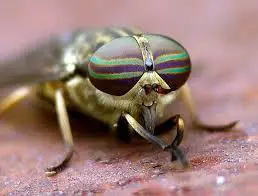The Top 5 Fastest Flying Insects on Earth
| Flying Insect | Speed (kph) | Speed (mph) | |
|---|---|---|---|
| 1 | Male horsefly (Hybomitra hinei) | 145.8 km/h | 90.5 mph |
| 2 | Brown planthopper (Nilaparvata lugens) | 80.6 km/h | 50.0 mph |
| 3 | Hawkmoth (sphingidaes) | 53.5 km/h | 33.3 mph |
| 4 | The common cleg (Tabanus bovinus) | 50.4 km/h | 31.31 mph |
| 5 | West indian butterfly (Nymphalidae prepona) | 48 km/h | 29.8 mph |
 Special Report
Special Report
What you'll learn:
- The Male Horsefly is Mach 5 fast.
- Jerry Butler and the coolest science experiment ever.
- Insects that fly are wonders of physics.
- It's hard work to calculate the airspeed of tiny little insects.
And much, much more...
The Male Horsefly is Fast & Furious Fast When Chasing Girl Horseflies
The male horsefly. That little devil is the fastest flying insect ever recorded, but only when chasing girl horseflies apparently. It flies at at an amazing 90 miles per hour (145 KPH), which would be like 4,000 miles per hour (6,000 KPH) if the Horsefly were the size of a human. That's around Mach 5. Wow. If Chuck Yeager were alive he'd probably want to test-fly one of those giant ones (which don't exist thankfully).Horseflies and Guns: a Learning Opportunity
Get ready for this because this is pretty incredible: the calculation of the speed of the male horsefly is attributed to Jerry Butler, an entomologist at the University of Florida, who once got a male Hybomitra to chase a plastic pellet fired from an air rifle; "Which it caught in midair and dropped," Butler says. From the speed of the pellet, he calculated the fly was going at least 90 miles per hour (145 km/h) at the beginning of female pursuit. Now that's a pretty cool science experiment don't you think? We here at Top5ofanything.com think Jerry Butler should be nominated for a Nobel Prize in science just for that experiment. If that was the only experiment that Jerry ever did in his life, then that would be enough and he could retire because nobody will ever top that.
Insect Airspeed: not an Easy Thing to Achieve or Calculate
The speed attainable by insects is currently poorly understood and insect airspeed is one of the least known features of flight performance. Probably because they are so tiny. It was once famously claimed by Charles Townsend that the Deer bot fly (Cephenemyia pratti) could reach speeds as high as 1,287 km/h (faster than the speed of sound) the true speed of this fly was later measured to be 40km/h. Irving Langmuir, the 1932 Nobel Prize winner, refuted this claim and calculated that to attain this speed (equivalent to half a horse power) the fly would have to consume 1.5 its own weight in fuel every second. He also calculated that the air pressure generated against the front of the insect at this speed would be be almost two atmospheres, sufficient to crush it's head.
We've got Locust and Earworm Airspeed Covered
The insects with the highest reliably measured airspeeds are desert locusts (Schistocerca gregaria) and corn earworm moths (Helicoverpa zea). These fly at average airspeeds of 33 and 28 km/h respectively (about 21 and 17 mph). Many insects surely fly faster, but their airspeeds have yet to be studied with modern methods. Insect airspeed is affected by mass, size, age, gender, feeding, water content, activity type, temperature, humidity, solar radiation, wind, oxygen level, ascent angle and even habitat isolation.
A Flying Insect is a Marvel of Physics
According to zoologist Charles Ellington, when an insect wing flaps, its front edge goes down and forward and then up and backward, tracing a flattened figure eight. That motion leads insect wings to attack the oncoming air at a high angle. An airplane wing, in comparison, has a relatively small angle of attack, almost parallel to the direction of travel. Increase the angle (by tilting the leading edge upward) and you increase the lift, but only up to a point. Tilt it more than 18 degrees, on a typical commercial airplane, and the airflow pulls away from the upper surface and the lift vanishes. This is called stalling. The secret of flapping insect wings, Ellington discovered, is that they are always on the edge of stalling, the point of maximum lift.
Please note that the speed of the Brown planthopper has likely been calculated with a wind assist.
Top 5 facts sources:- University of Florida Book of Insect Records
- T. J. Dean School of Physics
- University of New South Wales at the Australian Defense Force Academy
- Discover: The Physics of Insect Flight.
Sources: Top 5 of Anything entomological research 2021.
List Notes: Note: These insect speeds come from unsubstantiated literature and data. The highest airspeeds reported in refereed literature that were obtained using a reliable method are those of the desert locust (Schistocerca gregaria) which has an average speed of 33 km/h (+/- 3km). Many insects surely fly faster, but their air-speeds have yet to be studied with modern methods.

